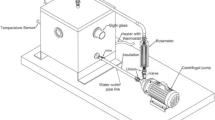Abstract
The use of copper as an anti-fouling surface is discussed and an electrochemical method for improving its performance is proposed. Seawater exposure trials of freely corroding, cathodically protected and electrochemically controlled copper specimens are described. The results show that the anti-fouling performance of copper surfaces may be improved by electrochemical control of its dissolution rates. The ultimate failure of the copper to anti-foul is due to insufficient dissolution rates. This may be due to electrochemical constraints, to the formation of insoluble corrosion products or to the precipitation of cathodic chalks at its surface.
Similar content being viewed by others
References
Navy Board Report, American Nepture, July (1941) 304.
D. R. Houghton, Mar. Eng. Rev. April (1979) 20.
G. W. Bryan, Proc. Roy. Soc. 177 (1971) 389. 389.
G. W. Bryan, in “Marine Pollution” Edited by R. Johnston Academic Press, New York and London, 1976 p. 185 290.
United Nations Report, Reports and Studies No. 2, Review of Harmful Substances (1976).
J. H. Wood, Rev. Int. Oceanogr. Med. 31 (2) (1973) 7.
F. H. De La Court and H. J. De Vries, Prog. Organic Coatings 1, 4 (1973) 375–404.
F. B. Laidlaw, in “Marine Fouling and its Preven
A. G. Lewis and W. R. Cave, Final Report of the International Copper Research Association, Inc., Project number 223 (1979).
K. W. Bruland, Earth Planetary Sci. Letts. 47 (1980) 176.
J. D. Burton and M. L. Young, in “The Northwest European Shelf Seas” edited by F. T. Banner, M. B. Collins and K. S. Massie (Elsevier, Amsterdam, New York and Oxford, 1980) pp. 495–516.
K. A. Pyefinch and J. C. Mott, J. Expt. Biol. 25 (1948) 276.
E. Steeman Nielsen and S. Wium-Anderson, Mar. Biol. 6 (1970) 93.
J. D. Ferry and B. H. Ketchum, in “Marine Fouling and its Prevention” (Woods Hole Oceanographic Institute, Mass, USA, 1952) pp. 277–302.
G. Bianchi and P. Longhi, Corr. Sci. 13 (1973) 853–864.
A. Zirino and S. Yamamoto, Lim. Oceanogr. 17 (1972) 661–671.
F. G. W. Smith, Biol. Bull. Woods Hole, 90(1) (1946) 51.
D. R. Houghton, I. Pearman and D. Tierney, Proceeding of the 3rd International Congress on the Marine Corrosion and Fouling (1972) p. 682–690.
O. Osborn and B. L. Prows, U.S. Patent number 3661 742 (1972).
E. Littauer and D. M. Jennings, Proceedings of the 2nd International Congress on Marine Corrosion and Fouling, Athens, Greece, 1968, pp. 527–536.
Author information
Authors and Affiliations
Rights and permissions
About this article
Cite this article
Swain, G.W.J., Farrar, R.A. & Hutton, S.P. The use of controlled copper dissolution as an anti-fouling system. J Mater Sci 17, 1079–1094 (1982). https://doi.org/10.1007/BF00543527
Received:
Accepted:
Issue Date:
DOI: https://doi.org/10.1007/BF00543527




